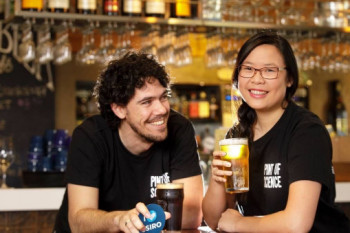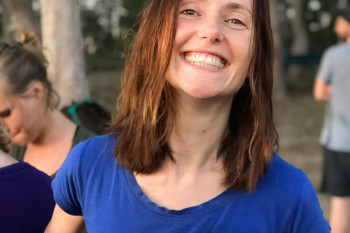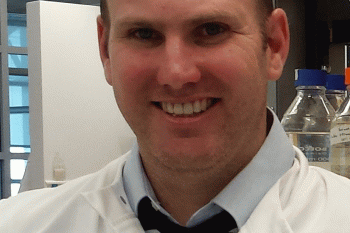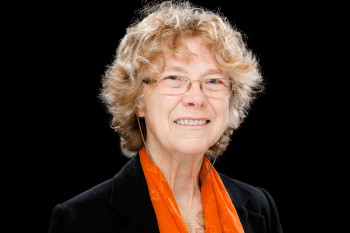© Pint of Science, 2025. All rights reserved.
Painting Pain
Dr Fereshteh Pourkazemi with Dr Larissa Fedunik
Dr Fereshteh Pourkazemi has combined her passion for visual art with her research in pain management to help patients with persistent pain holistically.
We caught up with the physiotherapist and University of Sydney senior lecturer on campus to chat about what inspired Fereshteh to develop the “Paint the Pain” pilot research study.
Fereshteh also shares some of the amazing artwork created by the study’s participants depicting the invisible burden of persistent pain.
~~
Fereshteh completed her PhD in 2014 and is a Senior Lecturer at the University of Sydney. She is a passionate physiotherapist, academic, and artist aiming to bring the arts, health, and education together to address the different aspects of human pain with a holistic view of its complexities.
You can find out more about Fereshteh at her website, or following her on Twitter (@FereshtehPK).
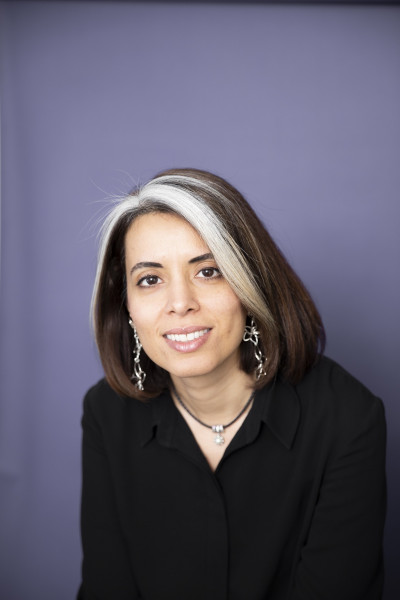
~~
Transcript
Dr Fereshteh Pourkazemi: So what we found from the discussions of our participants were connectedness, hope identity, meaning and empowerment.
Dr Larissa Fedunik: Hi everyone and welcome to Mug of Science. Mug's a Pint of Science initiative, where we're sitting down with local scientists and having a chat over a morning cuppa. I'm Larissa Fedunik, and today I'm at the Uni of Sydney's Camperdown campus, in the brand new Susan Wakil Health building, and I'm lucky enough to be joined by Dr Fereshteh Pourkazemi, who is a physiotherapist and a senior lecturer at USyd's Faculty of Medicine and Health. Thanks so much for joining us today, Fereshteh.
Fereshteh: Thank you very much for having me, Larissa.
Larissa: So Fereshteh's background and research is in the field of musculoskeletal injuries and pain, and as the pictures behind us sort of suggest, she's also a visual artist. She's worked on a pilot project to investigate the benefits of visual arts for patients who are dealing with persistent pain. So today we're going to be chatting about Fereshteh's journey in science, and also the inspiration for combining her passions for health and art.
Fereshteh: Thank you, it would be my pleasure.
Larissa: So first up, what is in your Mug today?
Fereshteh: It's loose leaf black tea, no milk, no sugar. I usually like to have my black tea with some dates or something sweet on the side, but for today, just black tea.
Larissa: Ah nice, and you would you describe yourself as a tea or coffee drinker, or do you like both?
Fereshteh: I used to be a tea drinker, many cups per day then I converted to having a coffee in the morning, and then tea during the day.
Larissa: Very nice. Before we get into the science, let's talk about you as a person. So tell us about your hobbies outside of work. Definitely.
Fereshteh: So the things that I really like are taking long walks, sometimes listening to podcasts, listening to music or just listening to the sounds around me, especially if I'm walking in nature. Also painting. I should say that these aren't my paintings, but these are the paintings of some of the participants, so I didn't want to take credit for their work! But yes definitely painting and especially these days watercolour is the medium that I enjoy painting. Not very proud of it, but also sometimes binge watching.
Larissa: A very 2021 hobby. Yes great, so when did you start painting?
Fereshteh: Larissa, I think from the moment I remember, I always had a pencil and paper in hand. I didn't have dolls, that was one strange thing many people found about me. So if I went to a friend's place or a family member's place, they would give me a doll as a child, I didn't like it. But pencils and papers were my best friends. Since then I've been painting. There have been times that I didn't do painting as much, so I was more focused for example during my PhD, especially the first two or three years, but towards the end of the PhD suddenly I had this urge of painting again. I guess it was dealing with the stress of the final year. Two years ago I started with watercoulor again. Last year I painted 100 days back to back, one painting a day, to help with the stress of COVID and isolation and all that, but it was amazing.
Larissa: Wow, that is amazing and did you document this on your website or Insta?
Fereshteh: Yes, I was sharing it with my friends on my Instagram, just to keep me accountable.
Larissa: Yeah great, so what was your PhD on? You're a physiotherapist and also a researcher?
Fereshteh: Exactly, so my PhD was focused on one of the most common musculoskeletal injuries, and that's ankle sprains, which usually when people have ankle sprains they're prone to have repeated sprains, and we call it chronic ankle instability, and that is like up to 70 percent of people, but it hasn't been studied much about the context of pain in this population. So that was one of the things I identified potentially as a factor that can contribute to development of chronic ankle instability. That's where I started shifting towards persistent pain and studying persistent pain in musculoskeletal injuries.
Larissa: So what originally inspired you to become a physiotherapist?
Fereshteh: Very interestingly, and I guess that's very similar to many other younger adults who now are choosing their degrees, it was very ideal for us to become either doctors or engineers at the time. So I wanted to go into health and I thought I was going to go into medicine. I didn't get into medicine and my thoughts were, maybe I'll start and do study again to go to medicine. But we had a cousin and he encouraged me to go into physiotherapy and he said if you didn't like it then shift to medicine. I loved physiotherapy and I stayed in physiotherapy.
Larissa: Yeah great, and where did you study? So I understand you grew up in Iran.
Fereshteh: Yes, so I studied at Tehran University of Medical Sciences. I did my undergraduate there, then I did Masters by research there, and in 2010 I was very lucky that I got a scholarship, international scholarship, to come over here and continue that field of research at the University of Sydney. I kind of made the University of Sydney my second home when I came here. So it has been almost 11 years.
Larissa: Wow that's great. So when you first came to Sydney, were you splitting your time between research and clinically practicing as a physiotherapist?
Fereshteh: So that's when, especially in health sciences and any major that you need to deal with humans, you need to have registration of that a specific area to be able to practice. So when I came here, my time was divided into doing my PhD and also doing the registration exam in here to become registered, so then I was able to practice.
Larissa: Yeah cool, so how would you describe a typical week for you at the moment?
Fereshteh: To be honest I can't say there is a typical week in academia, because the times are divided between the research, and the deadlines come up if you want to apply for research grants. Then there is also teaching time, so exam times and classes come up, and it's very dynamic. It keeps changing, but mainly the first two days at this stage are teaching for me and then the next two days are focused on research and development of a new course, and usually over the weekend or on Friday afternoons I see patients. At home, painting, and all the other house-related work.
Larissa: Would you describe lecturing physiotherapy as quite sort of hands-on? Is there a challenge with lecturing, like it's not just writing equations on a board!
Fereshteh: Absolutely, and that was one of the nightmares for us last year, and our students did great and we recorded so many videos to help them understand the techniques. And our students act as patients for each other and we show them and demonstrate the techniques that they have to use.
Larissa: Yeah great, very important. So let's get to the 'Paint the pain' project. Can you tell me a bit about where the inspiration for this project came about?
Fereshteh: Absolutely. So the 'Paint the paint' project was something that was forming in the back of my mind. Part of it came from inside and seeing how the painting had helped me to go over the final year of my PhD. Part of it was because I had seen benefits in other people, and part of it was, I knew that I'd love to stay in academia and I would love to do research, but with work-life balance, it would be better to make it work-life integration. So I thought, let's bring something that I love from the life into my work. And that's where I started looking into what has been done in this area. There has been some work in this area, of course. We have the art therapy profession, and there is a lot of work in that area, especially with mental health. There has been a lot of work in the area of persistent pain and there has been some limited work using artworks to express and assess pain, but not to offer some maybe treatment for pain. At that time, I realised that also there has been a move to incorporate arts into health. That was around 2016 in Australia, and I felt that it was a very good time to start bringing all that I love together, so I can enjoy the work-life integration even more. That's where it's coming from, and that's why I started doing this.
Larissa: Great, and what does the project actually involve? How do the patients integrate visual arts into their treatment?
Fereshteh: So one thing is that we didn't want to claim that this is going to be a treatment for persistent pain. There are great patient-centred pain management programs. They are the standard of care for these patients, but our patients are placed on long waiting lists to receive these treatments. During that time that they are waiting in pain, we thought, let's bring something for them that is joyful. So I contacted the Art Gallery of New South Wales, and I got in touch with the Access program director, and she was amazing, meeting with me and she said yes, let's do it. Then I went to the RPA Hospital pain management clinic and I suggested while the patients are awaiting these, can they be referred to us if they were willing to, to just come to the art gallery over five weeks with artists and us. In there, we help them to go through some artworks, to create some artworks and then discuss the artworks and we were able to do the first phase of the pilot study in around October, November 2019.
Larissa: Yeah great, so could you talk us through some of the paintings that we have behind us here?
Fereshteh: Absolutely. These are some of the amazing works of only two of our participants. So we had five sessions of art observation and art creation. The first session we tried to have a bit of ice breaker so people are more comfortable to create artworks, because it's intimidating if you haven't touched a pencil or paper for some time. And then the second session, we talked about something that was meaningful we saw in those artworks in the gallery, we discussed and then our participants painted what was meaningful for them. Third session, our topic was a bit difficult for our participants it was about pain. And the two ones on top that you see is the depiction of a participant's pain. And combined with their explanations, they are so unique that no question, no pain scale, can ever capture their experience. From the third session, we moved on to the topic of what if there is no pain, and you can see the shift in the artwork creations. So the same participant, this is the fourth session and the same participant, this is the fourth session as well. And we didn't want to finish our sessions with the topic of pain, so we wanted to finish with joy. And that's where it is, the joy painted by the same participant, and the joy in here as well. Now their statements and explanations about their paintings are amazing.
Larissa: Wow, so what benefits did patients describe after taking part in this project?
Fereshteh: Great question. So we assessed how this project might have benefited our patients in several ways. One was those normal questionnaires that are used in research with pain, which I should say our participants dislike, because they always feel that it doesn't capture their experience, but they are still as part of normal research. We gathered that data, we also collected cortisol level samples from saliva and heart rate. It's one biomarker for the level of stress. And then the third hour of each session was discussions. So what we found from the discussions of our participants were connectedness, hope, identity, meaning, and empowerment. Especially connectedness. So they were connected over their experience, and they were a very diverse group of participants, but they found connectedness over their experience, but also through art, through those sessions, and their artworks and their stories they shared, and they loved it. So these beautiful statements were not just moving for us, but also for other participants to understand and see the different experiences and perspectives that was about their pain.
Larissa: Wow, thank you. Thank you so much for sharing those experiences with us. So could you tell us a bit about the next stages of this project?
Fereshteh: Yes, the pilot stage has come to an end. There was a bit of difficulty when COVID started, but one amazing thing is that our art partners, the Art Gallery of New South Wales, as well as our health industry partners...We are applying for larger grants to continue searching into this area, doing research into this area, but also being able to offer this program, which our participants identified as very valuable, for the future.
Larissa: Excellent. So this is such a valuable endeavour for patients with persistent pain. What have you found to be the most rewarding aspect for you as a researcher?
Fereshteh: Well, I think I truly didn't expect to learn this much about the experience of pain. It's amazing that you think you have practiced, you have seen patients with pain, you have studied pain, you have experienced pain, and still every time a participant or an individual with pain or persistent pain, they share their story, it's so different and that shows such a multifaceted problem should be really dealt with and treated with multifaceted treatments. So that has been one of the most valuable experiences for me as a physiotherapist, as a researcher and as an artist, but also the fact that our participants loved this program, and they found it valuable is also something really heartwarming, and I really hope that we can take further steps to offer such programs to our society.
Larissa: Amazing. So thanks so much for your time today, Fereshteh.
Fereshteh: My absolute pleasure, thank you.
Larissa: So just to wrap up, we're asking all of our guests on Mug to complete the following sentence: to me, a scientist is someone who...
Fereshteh: To me, a scientist is someone who sees a problem but they don't pass a problem by. They stay, and they try to find answers for that problem for two reasons. Maybe their curiosity, but also for the greater good , and they are not biased in their findings. So if their findings do not support their hypothesis, they are not afraid to change and that's, to me, a scientist.
Larissa: Great answer. Thanks so much, Fereshteh.
Fereshteh: My absolute pleasure, thank you.
Larissa: Thanks everyone for watching Mug! Stay tuned for the next episode.
